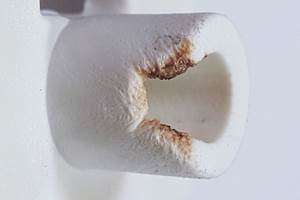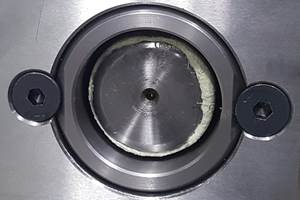Qualifying an Outside Molder? Look at the Tool Room
If custom molders were judged on curb appeal alone, this one would always be flush with work. Appointed in colonial brick encasing large smoked-glass windows and surrounded by balmy landscape and a lawn that looked good enough to eat, this stately plastics plant just screamed money. Surely they must be doing something right. But once past the glitz, the show was over.
My former employer’s relationship with this company started when something unusual happened in our molding plant. There were orders for more parts than we had presses to run them in. So the plant manager made a decision to send a couple of molds “outside.” The search focused on a molder that submitted an incredibly low quote. An administrative team was selected to make an initial visit to the prospective molder to qualify it as an acceptable source of plastic parts and molds. Sounded like a good plan.
The problem was that beyond understanding the bean-counting side of a molding operation, the two-man administrative team had little idea of what to use as qualifying criteria. When they pulled up in front of this plastic palace, both were immediately taken in by the fancy facade and were well on their way to being convinced that this company would do a fine job of running and maintaining our expensive high-cavitation, close-tolerance molds for medical parts. These molds would require as much care and attention to keep healthy as the patients who relied on the products they would produce.
A DAZZLING VISIT
Duly impressed, the visitors entered the foyer and stood transfixed by the brightly polished tooling components and colorful plastic products showcased in beautiful cabinetry. It all seemed to testify to the skill, organization, and dedication that must reside within.
The plant manager emerged and greeted the qualifiers with handshakes and trinkets, then led them back to his equally impressive office, where he dispensed more treats, camaraderie, and back-slapping.
By the time the group actually made it out to the molding floor, it was pretty much a done deal. Bearing gifts and grins, our qualifiers’ questions now tended to lean more toward lunch and golf than in-press mold-servicing schedules, toolroom experience, or preventive-maintenance programs.
Neither qualifier thought to ask to see the toolroom, the heart of a molding company, nor inquired as to where or how the molds were maintained. Both qualifiers were convinced that any company that looked this good must surely know how to run and take care of its molds—right? As it turned out, this was not the case.
WARNING FLAGS RAISED
Our qualifying twosome returned home with full bellies and happy faces, tickled pink from the golf-course sun. They confidently proclaimed that the visit was a great success, the vendor was a wonderful discovery, and we should get a mold out to this company immediately.
When asked which mold we should send, they paused for a moment in thought. Still basking from the trip and under pressure to impress, they decided to send our brand-new, state-of-the-art, 48-cavity closure mold.
It was not a particularly complicated mold, but still required regular periodic maintenance and some attention to the tapered rails and gibs during production. Also, a complete disassembly of the internal components every 500,000 cycles would be required, or else galling of critical thrust washers or other internal stack components could occur.
We had six other molds just like it in design, but this mold was the first of what we proudly called our own improved design, constructed of all-stainless plates, shouldered and NiHard-plated cores, better venting, larger fountains for more cooling, and many other maintenance-friendly improvements. Besides being expensive and customized by our own repair techs, the mold was beautiful, and we felt no one else deserved the honor of the maiden run.
But no one really cared how the toolroom personnel felt about it, so the mold was crated up and sent out. Two weeks later, a phone call informed us that the new mold had a problem. It seems that during the run, several of the stripper-plate bushings had galled against the cores, and now they needed new tooling to eliminate the flash the galling had caused and get the mold back into production. This sounded strange, since this was an old problem that we thought we had eliminated with rollers on the gibs and a planned program of more frequent in-press mold servicing.
We inquired about the location of the galled bushings and cores in reference to the mold-cavity layout sheet, but were told they didn’t have a sheet made up yet. Red flag. We asked when was the last time they had greased or checked the tapered rails, and no one knew. Burning red flag.
It was obvious that simply replacing the tooling wouldn’t fix the problem for long and that something else was going on. But we were behind in production, and management communicated clearly that we did not have time for a lengthy mechanical dissection right now. So a toolroom shopmate and I were assigned to deliver the spare parts and offer our assistance for installing the tooling. In other words we had to just make it run. So off we went with $13,000 worth of new tooling.
NOT UP TO SNUFF
Unlike our original vendor qualifiers, we were instructed to bypass the fancy front entrance and to knock loudly on the back door of the plant. Here we were met and led through an obstacle course of shop equipment, mold parts, and random junk that indicated not only a lack of general housekeeping, but complete disregard for organization and shop pride.
In the center of the toolroom was a single bench about 2 ft across and no more than 6 ft long, barely capable of supporting a mold, let alone disassembling it. Seeing no overhead hoist, we inquired as to their means of mold handling and were told they simply used a fork lift in which to hang the mold with a chain as it was pried apart. “Old Fred’s been doing it this way for years,” we were assured. So in comes old Fred, with a patch over one eye, driving much too fast with our half-million-dollar mold.
Was that the end of the story? No. Could things get any worse. Yes, they did, but I’ll spare you the details. The moral of the story was simply that when qualifying an outside vendor, have an idea of what you need to look for before you get there. If you are paying for maintenance of the mold, you really need to understand the environment the mold will run in and how it will be cared for. Here are a few things to look for once you get past the lobby and into the plant.
ON THE MOLDING FLOOR
When walking out to the molding floor, do you see any company or production goals posted on bulletin boards or walls? Such postings indicate communication and a sense of teamwork between departments and personel.
You also should see basic equipment such as a bridge-crane in the molding area to safely and efficiently pull and set molds, or at least an overhead hoist at each press.
Look around the presses for parts left over from previous runs of different products. Mixing products can be a death sentence in molding, especially in medical molding.
Examine how water fittings are connected to the mold. If you see loads of jumpers or worn, frayed, untied, and stretched water and oil lines, those are more causes for concern. Does the press look relatively clean and free of oil or water leaks—in other words, like it receives periodic maintenance?
Listen for presses that are closing or opening hard or that use multiple ejector strokes where they are not needed. Look at stopped molds (are there several?) for signs of dry interlocks, pins, bushings, and other components.
Ask to see the electronic or paper trail of run/repair records from the moment a mold is set through a production run. How are part issues, cycles, and performance problems communicated to the tool room?
Do you see any mold setup carts? How are last shots and samples of bad parts collected and stored for the toolroom to use as diagnostic tools?
Ask if molds receive regular in-press servicing documentation, which is a must for many long-running molds to maximize tooling life.
How does the molding floor communicate critical mold information back to the toolroom, and then to you, the customer?
IN THE REPAIR SHOP
After the molding floor walk-through, head directly to the tool room. Housekeeping practices will be apparent as soon as you walk in and are a good indicator of shop habits and how molds are maintained.
Benches should be robust and equipped with utilities. Are they located close to any kind of machine that creates chips, dust, or grit?
Shop equipment such as metal cut-off saws, bead or sand blasters, grinders, mills, and solvent tanks operating in close proximity to primary mold-assembly benches, precision equipment, or surface plates means that attention to detail and accurate measurements won’t happen here.
Look around the shop for other signs of disorder. Are there old rags, used tooling, and grimy junk lying around or stuffed into beat-up cabinets whose doors won’t even shut? Notice spills of oil, water, and solvent on the floor. If you see shim stock everywhere, contaminated grease tubes, or old and new tooling lying around untagged, these are not signs of an organized shop.
How are mold plates and tooling cleaned? The old way with brushes, Scotch-Brite, and sandpaper? Or have they moved up to ultrasonics and dry-ice blasting? Do they have basic machine-shop equipment for standard repairs, and is it in good working condition?
Are there procedures in place that dictate the level and type of mold preventive maintenance based on cycles or hours run? Is new tooling stored in an organized and safe manner?
Is there a standard form used for a maintenance plan or a work-order system? You’ll want to see much more than “Mold needs repair” and “Mold repaired” written in a text field of a work order stashed in a filing cabinet.
Ask to see how they document corrective actions implemented on mold and part defects. Do they track why and when molds are stopped or pulled? Will you receive regular, detailed reports of tooling and labor costs—or just get a bill?
Accurate record keeping requires discipline. You need it to avoid the amnesia that seems to occur whenever a mold goes down at an outside vendor.
COMPANY CULTURE COUNTS
The majority of companies attempting to acquire new business recognize the need to be outfitted with at least the basic machinery and equipment to be competitive. But some have not, electing instead to work in Spartan conditions with archaic technology and an undermanned, inexperienced, and underpaid workforce that will allow them to be the lowest of lowball bidders.
The production and maintenance culture learned over the years and practiced every day will be evident in many phases of a molding operation. There are many qualified molders who will run and care for your mold like it was their own. They will want you to tour the molding and shop areas so they can better demonstrate their capabilities and professional, systemized approach.
And there are others who will hustle you through, who pay little attention to a mold until it locks up, and then bill you for tooling used to fix something—they can’t say exactly what.
About The Author
Steven Johnson worked as a toolmaker for 26 years, rebuilding and repairing multicavity molds for Calmar Inc. and then as mold-maintenance engineer for Hospira Inc., a medical device manufacturer. Today, he is the maintenance systems manager for Progressive Components and has his own business, MoldTrax in Ashland, Ohio, which designs and sells software for managing mold maintenance (www.moldtrax.com). He can be reached at steve@moldtrax.com or (419) 289-0281.
Related Content
Improve The Cooling Performance Of Your Molds
Need to figure out your mold-cooling energy requirements for the various polymers you run? What about sizing cooling circuits so they provide adequate cooling capacity? Learn the tricks of the trade here.
Read MoreWhere and How to Vent Injection Molds: Part 3
Questioning several “rules of thumb” about venting injection molds.
Read MoreBack to Basics on Mold Venting (Part 1)
Here’s what you need to know to improve the quality of your parts and to protect your molds.
Read MoreWhat You Need to Know About Leader Pins and Bushings
There’s a lot more to these humble but essential mold components than you might suspect. Following the author’s tips could save much time, money and frustration.
Read MoreRead Next
Why (and What) You Need to Dry
Other than polyolefins, almost every other polymer exhibits some level of polarity and therefore can absorb a certain amount of moisture from the atmosphere. Here’s a look at some of these materials, and what needs to be done to dry them.
Read MoreAdvanced Recycling: Beyond Pyrolysis
Consumer-product brand owners increasingly see advanced chemical recycling as a necessary complement to mechanical recycling if they are to meet ambitious goals for a circular economy in the next decade. Dozens of technology providers are developing new technologies to overcome the limitations of existing pyrolysis methods and to commercialize various alternative approaches to chemical recycling of plastics.
Read MorePeople 4.0 – How to Get Buy-In from Your Staff for Industry 4.0 Systems
Implementing a production monitoring system as the foundation of a ‘smart factory’ is about integrating people with new technology as much as it is about integrating machines and computers. Here are tips from a company that has gone through the process.
Read More

















.png;maxWidth=300;quality=90)











